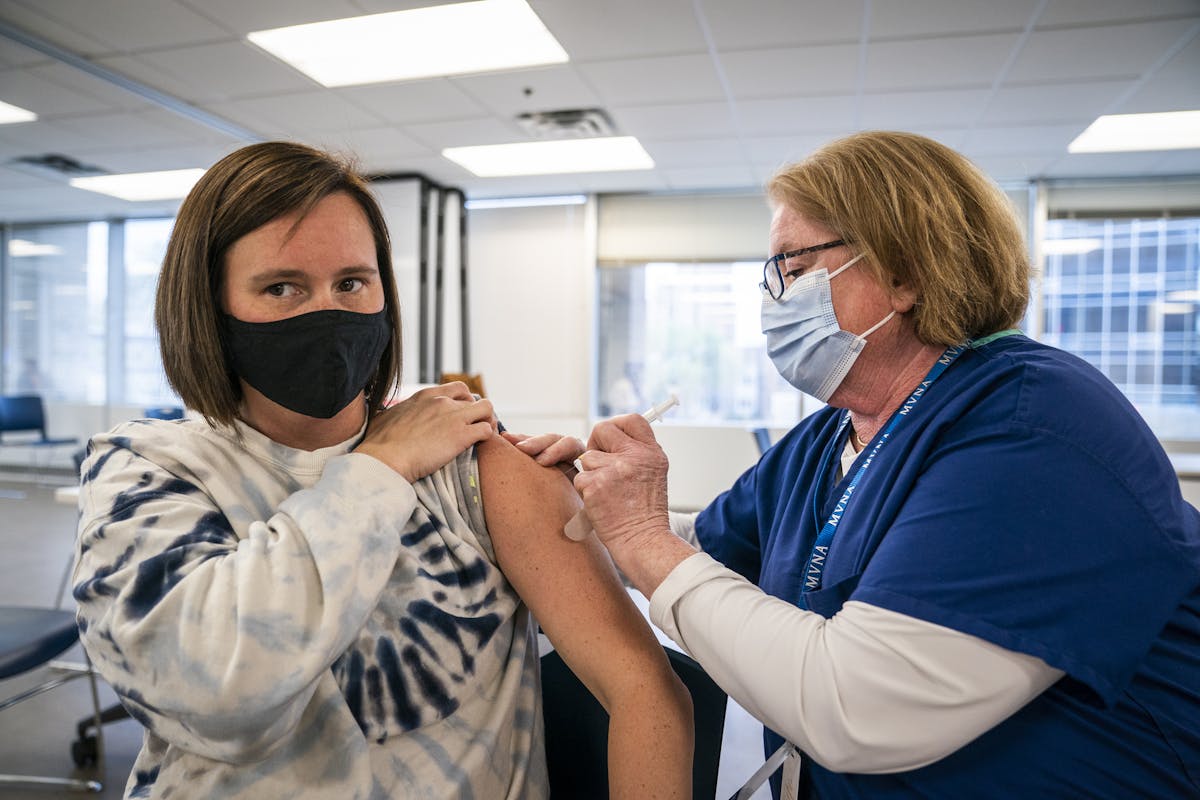Gov. Tim Walz met with business leaders Friday to discuss further easing of COVID-19 restrictions and dangled the prospect of a "normal" Minnesota State Fair this summer if pandemic progress continues.
The governor commended Minnesotans for a vaccine uptake rate that "out-vaccinated the surge" of viral activity over the past month and kept hospitals from being overrun. While global concerns of COVID-19, especially the outbreak in India, could result in new viral variants presenting new threats, Walz said Minnesota is on pace for a promising summer.
"The touchstone place is [the] State Fair," Walz said. "Everything looks to me on the horizon, and where the vaccine is going and the way that the virus is responding, that that should be a pretty-close-to-normal event."
Walz's comments on Friday came as Minnesota reported 16 more COVID-19 deaths along with 1,877 infections. The state appears on the downside of a third wave of pandemic activity. The seven-day average positivity rate of COVID-19 testing rose from 3.5% on March 3 to 7.5% on April 8 but has since declined to 6.3%.
The daily figures raise Minnesota's totals to 7,144 COVID-19 deaths and 575,812 diagnosed infections in the pandemic.
Walz credited Minnesota's rapid vaccination progress for avoiding an exponential level of COVID-19 growth in the latest wave — especially given the broad spread of a more infectious B.1.1.7 variant that caused higher levels of pandemic activity in Michigan.
More than 2.5 million people in Minnesota have received some COVID-19 vaccine and nearly 1.9 million of them have completed the one- or two-dose series. About 57% of Minnesota's eligible population of people 16 and older have received vaccine, including nearly 87% of senior citizens, who are more vulnerable to severe COVID-19.
"They nearly spiked out [in Michigan] on hospital space," Walz said. "They had a pretty catastrophic situation. We probably had the same amount of virus circulating and B.1.1.7, but we were about 10 percentage points higher on vaccination, and that made the difference."
Hospitalizations of COVID-19 cases in Minnesota increased from 210 on March 6 to 699 on April 14, but declined as of Thursday to 619.
Minnesota had the fifth-highest rate of new COVID-19 infections last week, according to the most recent White House COVID-19 state report. Walz said he hopes epidemiologists will study why Minnesota was unique for having such a high rate of B.1.1.7 — estimated to be causing more than 60% of the new infections in the state — and how a variant first identified in England gained a foothold here.
"Is it because of the hub of the airport?" he said. "What happened there?"
State health officials remain concerned about the spread of other concerning variants identified in Brazil and South Africa that have sent some younger Minnesotans into hospitals. Minnesota also reported its third pediatric COVID-19 death in the pandemic this week — identified via obituary information as 6-year-old Week Day, a first-grader in Marshall, Minn., who was born in Thailand and loved school and the color pink and singing and dancing.
State health officials do not yet know if a variant was involved in the case of Day, who died Sunday in a hospital in South Dakota, but officials are concerned because she was Minnesota's first pediatric death that didn't involve underlying health conditions or other complicating factors.
More than 1,000 SARS-CoV-2 infections have been identified in each of the past two weeks in pre-K-12 students — numbers that exceed the most severe waves of the pandemic last fall. While health officials are encouraging students age 16 and 17 to seek Pfizer vaccine — with the Moderna and Johnson & Johnson versions requiring a minimum age of 18 — officials also are hoping to use increased testing to identify and slow down any viral spread.
At least 118 private and public school districts have taken up Minnesota's offer last week of free COVID-19 test kits for students. Sixteen clubs representing six different sports have requested 837 test kits as well.
"As much as we feel like things are improving, there is still a lot of virus out there," state Health Commissioner Jan Malcolm said.
While businesses and entertainment venues have largely reopened, Walz is considering an announcement next week that would expand their capacity levels. Restaurants and bars remain capped at 75% of their fire code capacity, but also must maintain social distancing requirements to keep customer groups from presenting viral transmission risks to one another.
Outdoor seated venues such as Target Field are capped for now at roughly 25% capacity.
Walz also reported progress after in-person meetings with Senate Republicans who are eager for the governor to set aside emergency powers that he has used to make decisions such as an indoor mask mandate without legislative approval during the pandemic.
The governor said he doesn't want to cancel the emergency order altogether. That could shutter a federally supported vaccination site at the State Fairgrounds and cause the state to lose up to $40 million in federal supplemental assistance. But the leaders at least discussed the "off-ramp" conditions in the pandemic under which those powers could be set aside.
Jeremy Olson • 612-673-7744

Want to share info with the Star Tribune? How to do it securely

'Safe recovery sites' would offer syringes, naloxone and more to people using drugs. The plan could be in peril.
New Minnesota GOP leaders seek peace with party's anti-establishment wing

Who is Republican Lisa Demuth, Minnesota's first House speaker of color?

